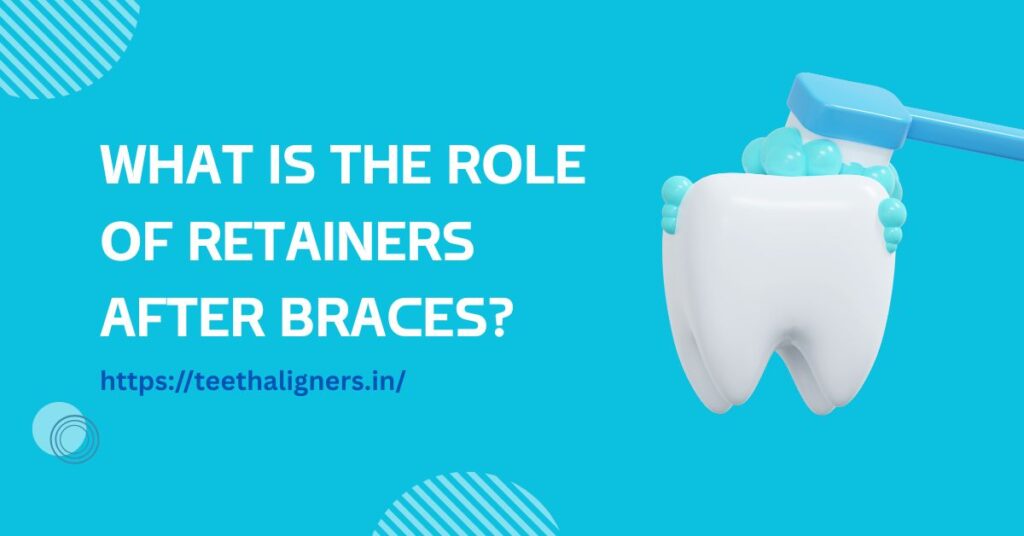Finishing orthodontic treatment can feel like reaching the finish line. After months or even years of adjustments, dental visits, and wearing braces, patients are often thrilled to finally see their teeth aligned and their smile transformed. Yet, this is not the end of the journey.
The brackets and wires may come off, but one last phase ensures that the results of all that effort will last: wearing retainers.Retainers are often underestimated because of their simple appearance.
They do not move teeth like braces or aligners, but they safeguard the progress achieved. Without them, teeth could slowly return to their old positions, leaving patients frustrated after years of commitment.
Whether you are in South Delhi or any other city, understanding why retainers matter and how they function will help you keep your smile stable for years to come.
Table of Contents
ToggleWhy Retainers Are Needed After Braces
Teeth Want to Move Back
Teeth are supported by tissues and ligaments that allow for natural flexibility. During orthodontic treatment, teeth are shifted to new positions, but the tissues that hold them in place do not adapt instantly.
Once braces are removed, there is a tendency for teeth to move back toward their original positions. This process, called relapse, can undo months of progress if a retainer is not worn.
Retainers act like a gentle guard, holding teeth where they should be while the surrounding structures adjust. Even patients who complete treatment with clear corrective aligners need this support, since their teeth are just as likely to shift without proper retention.
Supporting Bone and Gum Adjustment
Every tooth sits within bone and gum tissue. When teeth are moved, the bone remodels around them, and the gums also need time to adapt. This process takes months and sometimes years.
Retainers keep teeth steady during this sensitive adjustment period, much like scaffolding supports a building until it is strong enough to stand on its own. Without this support, the alignment can weaken, and teeth may shift.
Long-Term Stability
Even after the first few months, teeth remain capable of shifting throughout life. Daily habits like chewing, clenching, or even slight grinding can put pressure on teeth.
As people age, their teeth may naturally crowd, especially in the lower front area. Retainers provide the necessary stability to prevent unwanted changes and protect the investment made in orthodontic care.
Types of Retainers
Removable Retainers
Removable retainers are among the most common options. They are typically made of clear plastic or acrylic combined with thin wires. Patients can easily take them out to eat, brush, or floss.
This convenience makes them appealing, but it also creates the risk of forgetting to wear them. For the best results, patients must be consistent with use as instructed by their orthodontist.
Clear Plastic Retainers
Clear plastic retainers resemble aligners and are valued for their discreet look. They are nearly invisible and comfortable to wear, making them popular among adults and teenagers who want to maintain confidence in their daily activities.
In places like South Delhi, where appearance is often a priority, clear retainers are frequently chosen for their subtle style.
Fixed Retainers
Fixed retainers consist of a thin wire bonded to the back of teeth, usually the lower front ones. Because they remain in place at all times, they remove the risk of forgetting to wear them.
However, cleaning around fixed retainers requires careful brushing and flossing to prevent plaque buildup. For patients who may struggle with remembering nightly wear, fixed retainers are a reliable alternative.
How Long Do You Need to Wear Retainers?
The First Few Months
Right after braces are removed, teeth are most vulnerable to relapse. For this reason, orthodontists usually recommend full-time wear of retainers during the first several months. This constant use helps stabilize teeth in their new positions while the bone and gums adapt.
Transitioning to Nighttime Wear
Once the initial stabilization period passes, many orthodontists allow patients to wear retainers only at night. This shift provides freedom during the day while still maintaining alignment. Wearing a retainer while sleeping is usually easy to adjust to, and it quickly becomes a natural part of a bedtime routine.
Lifelong Maintenance
In reality, retainers are not only for the short term. Many patients benefit from wearing them a few nights a week for life. Teeth are never completely fixed; they are always under subtle pressure from daily activities.
A retainer works as a long-term safeguard, ensuring that the straight smile achieved through treatment remains intact. Some orthodontists compare teeth to memory foam: without reinforcement, they always try to return to their original shape.

What Happens If You Don’t Wear a Retainer?
Skipping a retainer may seem harmless at first, but the consequences build quickly. Within weeks, small shifts may occur. Over months, gaps can reappear, and teeth may become noticeably crooked again.
For some patients, relapse can happen so significantly that they require another round of orthodontic treatment.The impact is not limited to appearance.
Misaligned teeth can make chewing less efficient, speech less clear, and cleaning more difficult. This raises the risk of cavities and gum problems. The disappointment of losing the results after years of effort highlights why consistent retainer wear is so important.
Caring for Retainers
Daily Cleaning
Retainers come into contact with saliva, food particles, and bacteria. Cleaning them daily is essential. Removable retainers should be rinsed after meals and brushed gently with a soft toothbrush and mild soap. Hot water should be avoided, as it can warp plastic materials.
Storage Tips
When not in use, retainers should always be kept in a protective case. Many retainers are lost when wrapped in tissue and accidentally thrown away. A sturdy case prevents loss and protects against damage.
Dental Visits
Regular check-ups give orthodontists the chance to monitor retainers. They may repair cracks, make adjustments, or provide replacements if needed. These visits keep the retainer effective and comfortable while also giving patients reassurance about their oral health.
Patient Stories: Why Retainers Make a Difference
Consider two patients who completed treatment at the same time. The first followed every instruction and wore their retainer consistently.
Years later, their teeth remained perfectly aligned. The second often forgot to wear the retainer. Within months, gaps appeared, and their smile gradually returned to its earlier state.
Stories like these highlight that the effort required for retainer use is small compared to the potential setback of relapse. Consistency is the deciding factor between keeping a straight smile for life and losing it in just a short time.
Do Retainers Feel Uncomfortable?
It is common for new retainers to feel snug at first. Patients may experience slight pressure or tightness, but this usually means the retainer is working correctly. Within a few days, the sensation fades, and speaking or wearing the retainer becomes normal.
If a retainer causes lasting discomfort or creates sores, an orthodontist can make adjustments to improve the fit. Most patients adapt quickly, and retainers become a routine part of daily life.
Retainers and Oral Health
Retainers do more than maintain straight teeth; they also promote better oral health. Properly aligned teeth make chewing more efficient and reduce stress on the jaw.
They also prevent uneven wear, which can occur when teeth do not meet correctly.From a hygiene perspective, straight teeth are easier to brush and floss.
When teeth are crowded or shifting, it becomes harder to clean between them, which can increase the risk of cavities and gum disease. By keeping teeth aligned, retainers indirectly protect oral health for the long term.
Cost and Accessibility of Retainers
The price of retainers depends on the type and material used. Removable plastic retainers are often more affordable, while fixed retainers may carry higher costs due to the bonding procedure.
Replacements also add to expenses if a retainer is lost or damaged.Still, retainers are far less costly than repeating orthodontic treatment.
Clinics like us provide guidance on how to care for retainers properly, helping patients avoid unnecessary replacements. For families, this advice is especially valuable, as it protects both smiles and budgets.
Common Myths About Retainers
Some people believe retainers are only temporary, worn for a year at most. In truth, long-term use is often recommended to keep teeth from shifting back. Others assume that retainers are only for younger patients, but adults also experience shifting teeth.
Finally, there is a misconception that retainers can weaken teeth. In reality, retainers are harmless when used correctly, and they strengthen dental health by keeping alignment steady.
Retainers vs. Clear Aligners
At first glance, retainers and clear aligners may look alike, but their purposes are different. Clear aligners actively move teeth into better positions, while retainers keep teeth steady after movement.
Patients sometimes confuse the two, but understanding the distinction helps them appreciate the final role retainers play in treatment.
Lifestyle Tips for Living With Retainers
Making retainers part of daily life does not need to be difficult. Many patients keep a small case in their bag or pocket so their retainer is never misplaced during meals. Others invest in a backup set in case one is lost.
Patients who grind their teeth at night can ask about retainers that double as protective guards. Most importantly, consistency matters. Even during travel or busy days, wearing retainers regularly prevents setbacks that can occur from just a few missed nights.
Conclusion
Retainers may appear simple, but they are vital to preserving the results of orthodontic treatment. They prevent relapse, support bone and gum adjustments, and provide lifelong stability for straightened teeth.
With proper cleaning, careful storage, and routine dental check-ups, retainers become an easy habit that safeguards the investment made in a healthy, confident smile.The effort of orthodontic care should not be undone by neglect.
By embracing retainers as a natural part of dental care, patients can enjoy the benefits of their treatment for decades. A strong smile requires commitment, and retainers are the final step in keeping that commitment alive.

